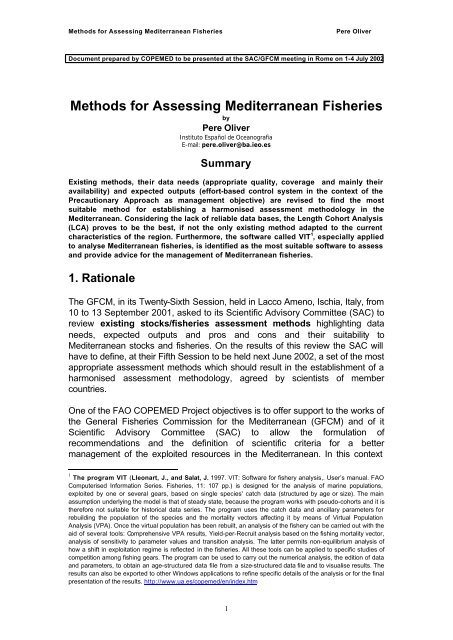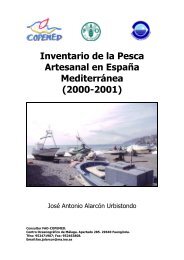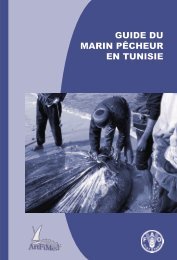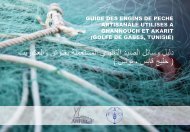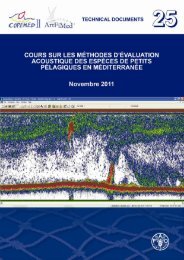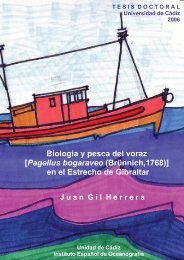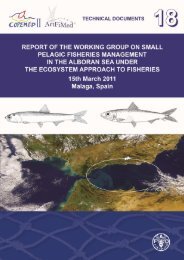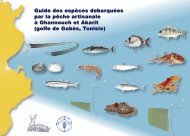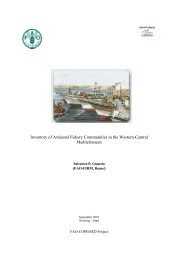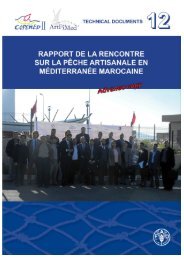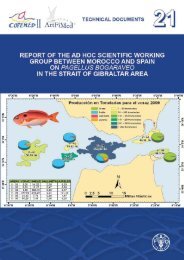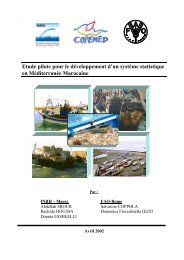Methods for Assessing Mediterranean Fisheries - Fao - Copemed
Methods for Assessing Mediterranean Fisheries - Fao - Copemed
Methods for Assessing Mediterranean Fisheries - Fao - Copemed
Create successful ePaper yourself
Turn your PDF publications into a flip-book with our unique Google optimized e-Paper software.
<strong>Methods</strong> <strong>for</strong> <strong>Assessing</strong> <strong>Mediterranean</strong> <strong>Fisheries</strong><br />
Pere Oliver<br />
Document prepared by COPEMED to be presented at the SAC/GFCM meeting in Rome on 1-4 July 2002<br />
<strong>Methods</strong> <strong>for</strong> <strong>Assessing</strong> <strong>Mediterranean</strong> <strong>Fisheries</strong><br />
by<br />
Pere Oliver<br />
Instituto Español de Oceanografia<br />
E-mail: pere.oliver@ba.ieo.es<br />
Summary<br />
Existing methods, their data needs (appropriate quality, coverage and mainly their<br />
availability) and expected outputs (ef<strong>for</strong>t-based control system in the context of the<br />
Precautionary Approach as management objective) are revised to find the most<br />
suitable method <strong>for</strong> establishing a harmonised assessment methodology in the<br />
<strong>Mediterranean</strong>. Considering the lack of reliable data bases, the Length Cohort Analysis<br />
(LCA) proves to be the best, if not the only existing method adapted to the current<br />
characteristics of the region. Furthermore, the software called VIT 1 , especially applied<br />
to analyse <strong>Mediterranean</strong> fisheries, is identified as the most suitable software to assess<br />
and provide advice <strong>for</strong> the management of <strong>Mediterranean</strong> fisheries.<br />
1. Rationale<br />
The GFCM, in its Twenty-Sixth Session, held in Lacco Ameno, Ischia, Italy, from<br />
10 to 13 September 2001, asked to its Scientific Advisory Committee (SAC) to<br />
review existing stocks/fisheries assessment methods highlighting data<br />
needs, expected outputs and pros and cons and their suitability to<br />
<strong>Mediterranean</strong> stocks and fisheries. On the results of this review the SAC will<br />
have to define, at their Fifth Session to be held next June 2002, a set of the most<br />
appropriate assessment methods which should result in the establishment of a<br />
harmonised assessment methodology, agreed by scientists of member<br />
countries.<br />
One of the FAO COPEMED Project objectives is to offer support to the works of<br />
the General <strong>Fisheries</strong> Commission <strong>for</strong> the <strong>Mediterranean</strong> (GFCM) and of it<br />
Scientific Advisory Committee (SAC) to allow the <strong>for</strong>mulation of<br />
recommendations and the definition of scientific criteria <strong>for</strong> a better<br />
management of the exploited resources in the <strong>Mediterranean</strong>. In this context<br />
1 The program VIT (Lleonart, J., and Salat, J. 1997. VIT: Software <strong>for</strong> fishery analysis,. User’s manual. FAO<br />
Computerised In<strong>for</strong>mation Series. <strong>Fisheries</strong>, 11: 107 pp.) is designed <strong>for</strong> the analysis of marine populations,<br />
exploited by one or several gears, based on single species' catch data (structured by age or size). The main<br />
assumption underlying the model is that of steady state, because the program works with pseudo-cohorts and it is<br />
there<strong>for</strong>e not suitable <strong>for</strong> historical data series. The program uses the catch data and ancillary parameters <strong>for</strong><br />
rebuilding the population of the species and the mortality vectors affecting it by means of Virtual Population<br />
Analysis (VPA). Once the virtual population has been rebuilt, an analysis of the fishery can be carried out with the<br />
aid of several tools: Comprehensive VPA results, Yield-per-Recruit analysis based on the fishing mortality vector,<br />
analysis of sensitivity to parameter values and transition analysis. The latter permits non-equilibrium analysis of<br />
how a shift in exploitation regime is reflected in the fisheries. All these tools can be applied to specific studies of<br />
competition among fishing gears. The program can be used to carry out the numerical analysis, the edition of data<br />
and parameters, to obtain an age-structured data file from a size-structured data file and to visualise results. The<br />
results can also be exported to other Windows applications to refine specific details of the analysis or <strong>for</strong> the final<br />
presentation of the results. http://www.ua.es/copemed/en/index.htm<br />
1
<strong>Methods</strong> <strong>for</strong> <strong>Assessing</strong> <strong>Mediterranean</strong> <strong>Fisheries</strong><br />
Pere Oliver<br />
COPEMED in close agreement with the SAC President decided to finance the<br />
preparation of this document.<br />
2. Background<br />
2.1. Stock assessment methods and their use in the<br />
<strong>Mediterranean</strong><br />
There are currently three dominant approaches to fisheries stock assessment:<br />
1. Simple models of biomass dynamics (often called surplus production models<br />
or global models) that rely only on catch and some index of abundance.<br />
2. Analytical models: Analysis of length frequency data of catches (often called<br />
Length Cohort Analysis – LCA).<br />
3. Analytical models: Analysis of catch-at-age data (often called Virtual<br />
Population Analysis – VPA).<br />
There is an abundant literature on these methods and many manuals have been<br />
published to describe them and to facilitate their use. Among them the Manual of<br />
Fish Stock Assessment (Cadima, 2002), recently published by FAO is<br />
recommended to find out more about these methods. The possibilities of<br />
applying these different population dynamics methodologies to the<br />
<strong>Mediterranean</strong> are also discussed by Lleonart (1993).<br />
Since remote antiquity, the <strong>Mediterranean</strong> has been the object of observations<br />
and descriptions in which maritime activities and fishing occupy a paramount<br />
place. The very rich <strong>Mediterranean</strong> fauna and the highly multispecific nature of<br />
catches certainly favoured the fact that the first works were mainly oriented<br />
towards attempts exhaustive descriptions of the vital cycles and<br />
biological parameters of a given species (Demiere,1979, Quesada, 1991) 2 .<br />
Umberto D'Ancona's observations on <strong>Mediterranean</strong> fisheries and variations in<br />
fish populations as a result of changing fishing patterns after the first World War<br />
allowed Lotka and Volterra to establish the mathematical foundations of<br />
population dynamics in the 1920s. However, the transition from marine biology<br />
sensu stricto to fisheries research is relatively recent in the <strong>Mediterranean</strong>. We<br />
can consider that the first practical attempts to apply some mathematical<br />
population dynamic models to exploited stocks were carried out in France and<br />
Spain in the late 1960s. Most of these first analyses used global production<br />
models. However, these models of classic use in fisheries exploiting<br />
monospecific resources by means of a single type of gear, and <strong>for</strong> which they<br />
2 Cadima, E.L. (2002). Manual of fish stock assessment. FAO <strong>Fisheries</strong> Technical, 393: 170p.<br />
Lleonart, J. (1993). <strong>Methods</strong> to analyse the dynamics of exploited marine populations: Use and development of<br />
models. Sci. Mar., 57(2-3): 261-267.<br />
Quesada, M.A. 1991. Parametros biolódgicos de peces, crustaceos y moluscos del Mediterraneo occidental.<br />
Recopilación bibliografica (1950-1990). Inf. Tec. Inst. Esp. Oceanogr., 102: 173 pp.<br />
Dremiere, P.Y. 1979. Parametres biologiques et dynamiques disponibles sur les principaux stocks halieutiques du Goife<br />
du Lion: sous-zone 37.2 du CGPM. FAO Fish. Rep., 227:111-127 p.<br />
2
<strong>Methods</strong> <strong>for</strong> <strong>Assessing</strong> <strong>Mediterranean</strong> <strong>Fisheries</strong><br />
Pere Oliver<br />
were designed, prove to be quite disappointing when applied in the<br />
<strong>Mediterranean</strong> Sea.<br />
These models have a sort of "black box" vision of fisheries in which only one<br />
data entry, the fishing ef<strong>for</strong>t and only one data output, the catch, are observable.<br />
Moreover, they require long data series and a calibrated measure of the fishing<br />
ef<strong>for</strong>t, which must present a certain range of variation to facilitate the analysis of<br />
catch variation. This being so, and given the characteristics of <strong>Mediterranean</strong><br />
fisheries and available data bases, production models are considered to<br />
have limited applicability <strong>for</strong> evaluation in this case. In the late 1980s and early<br />
1990s, the limitations of production models induced a group of north western<br />
<strong>Mediterranean</strong> fisheries scientists to adapt Virtual Population Analysis (VPA)<br />
techniques to <strong>Mediterranean</strong> fisheries.<br />
The Length Cohort Analysis (LCA) is a simplification of the Virtual Population<br />
Analysis (VPA) which assumes that the stock is in a state of equilibrium. The<br />
LCA is currently the most widely used method in the Western <strong>Mediterranean</strong>. It<br />
requires a knowledge of catch distribution by size classes and by gear and<br />
some estimation of the biological parameters of the species, and currently<br />
represents a clear line of progress <strong>for</strong> population dynamics in the<br />
<strong>Mediterranean</strong>.<br />
We shall cite also the Yield per Recruit (Y/R) analysis used on various<br />
occasions in the western <strong>Mediterranean</strong> throughout the 1980s. It makes use of<br />
simple estimates of the requisite dynamic and biological parameters (Oliver,<br />
1983). It can also use the more solid estimates of fishing mortality provided by<br />
VPAs and LCAs, together with length/weight and length/age relationships,<br />
estimating the yield (in biomass) of each recruit brought into the fishery <strong>for</strong><br />
different vectors of mortality. Y/R curves can thus be built by varying ef<strong>for</strong>t (fishing<br />
mortality) or gear selectivity (length at first capture), providing an enormously<br />
useful overview of the state of the stock. However,<br />
Direct evaluations of biomass have also been carried out to provide useful<br />
in<strong>for</strong>mation when statistical in<strong>for</strong>mation of fisheries is missing. However, the<br />
results obtained until now using this methodologies have been very<br />
limited.<br />
2.2. An historical overview on the last 25 years<br />
The early applications of stock assessment methods in the <strong>Mediterranean</strong> were<br />
promoted in the 1970s by the scientific Working Groups of the General <strong>Fisheries</strong><br />
Council <strong>for</strong> the <strong>Mediterranean</strong> (GFCM). These were Global Models under<br />
equilibrium, also called production models (GFCM, 1972; Charbonier and<br />
Caddy, 1986; Pereiro and Fernandez, 1974; Oliver, 1983) 3 . However, they<br />
3 Charbonier, D. & J.F. Caddy.- 1986. Report of the technical consultation of the General Fish Council <strong>for</strong> the<br />
<strong>Mediterranean</strong> on the methods of evaluating small scale fisheries in the Western <strong>Mediterranean</strong>. Sète, France, 13-16<br />
may, 1986. FAO Fish. Techn. Rep., 362, 155 pp.<br />
GFCM. 1972. Rapport de la troisieme session du Groupe de travail du CGPM sur 1'evaluation et 1'exploitation des<br />
ressources demersales. Athenes, 6-11 mars, 1972.<br />
Oliver, P. 1983. Los recursos pesqueros del Mediterraneo. Primera parte: Mediterraneo occidental.Etud.Rev.CGPM,<br />
59:135 p.<br />
3
<strong>Methods</strong> <strong>for</strong> <strong>Assessing</strong> <strong>Mediterranean</strong> <strong>Fisheries</strong><br />
Pere Oliver<br />
proved to be not very useful <strong>for</strong> the analysis of <strong>Mediterranean</strong> fisheries,<br />
mainly due to their severe theoretical restrictions, but also to the impossibility of<br />
distributing the ef<strong>for</strong>t among the different species to which the model is<br />
simultaneously applied that constituting an additional problem. To solve it, there<br />
were various attempts to apply the so-called Composite Production Models<br />
(GFCM, 1972; GFCM, 1980; Garcia, 1983; Caddy and Garcia, 1984; Chavance<br />
and Girardin, 1985; GFCM, 1988).<br />
The normal use of analytical models in the <strong>Mediterranean</strong>, actually LCA, was<br />
due to a co-operative research project of France, Italy and Spain, funded by the<br />
European Union, called “FARWEST - Study <strong>for</strong> assessment and management of<br />
fisheries in the western <strong>Mediterranean</strong>” and carried out in the period 1990-1994.<br />
As a consequence of this co-operative activity, in 1993 a Working Group on<br />
Population Dynamics (DYNPOP) was established in the framework of the<br />
International Commission <strong>for</strong> the Scientific Exploration of the <strong>Mediterranean</strong><br />
(ICSEM/CIESM) with the support of the International Centre <strong>for</strong> Advanced<br />
<strong>Mediterranean</strong> Agronomic Studies (CIHEAM). DYNPOP incorporated, in the<br />
period 1992-1996 (CIHEAM, 1995; CIHEAM, 1998) scientists from the eastern<br />
and mainly southern parts of the <strong>Mediterranean</strong>. Thanks to that, Length Cohort<br />
Analyses have been used during the last ten years to assess the main<br />
stocks and increasingly complete and reliable assessments are<br />
available.<br />
However, the availability of reliable data is again the main problem to use<br />
Virtual Population Analysis (VPA) based on long series of catch-at-age data<br />
and it was only possible to use Length Cohort Analysis (LCA) based on<br />
pseudocohorts built using length frequency data.<br />
For this reason, a group of Spanish fishery scientists developed a programme<br />
package based on LCA and Y/R analysis adapted to <strong>Mediterranean</strong><br />
fisheries called VIT (Lleonart and Salat, 1992). The program and the models<br />
underlying VIT software are conceived <strong>for</strong> the analysis of fisheries where the time<br />
depth of the in<strong>for</strong>mation available is limited and where the technical interaction<br />
among fishing gears is an important factor to account <strong>for</strong>. Data management<br />
routines (input), and tables and graphics output have also been conceived to<br />
analyse and to provide advice of <strong>Mediterranean</strong> fisheries. This software,<br />
designed to analyse the important competitive gear situation in the<br />
<strong>Mediterranean</strong>, was updated and translated into English in 1997 (Lleonart and<br />
Salat, 1997) 4 and recently it has also been adapted to a more friendly version <strong>for</strong><br />
Pereiro, J.A. and Femandez, A. 1974. Aplicacidn de los modelos de produccidn de Schaefer y Fox a las pesquerfas de<br />
Palinurus, Aristeus, Mullus, Pagellus y Solea de la plata<strong>for</strong>ma balear. Bol. Inst. Esp. Oceanogr., 181: 27 pp.<br />
4 Caddy, J.F. and Garcia, S. 1982. Production modelling without long data series. FAO Fish. Rep., 278: 309-313.<br />
Chavance, P. and Girardin, M. 1985. Niveaux d'exploitation en 1982 et potentialites regionales de la pecherie<br />
chalutiere algerienne. Application d'un modele de production composite. FAO Fish. Rep., 347:113-125 p.<br />
Ciheam, 1995. Cahiers Options Mediterraneennes, 10 :<br />
Ciheam, 1998. Cahiers Options Mediterraneennes, 35 :<br />
Garcia, S. 1983. Un exemple de 1'utilisation des modeles de production composites en Mediterranee espagnole. FAO<br />
Fish. Rep., 305: 97-105 p.<br />
GFCM. 1972. Rapport de la troisieme session du Groupe de travail du CGPM sur 1'evaluation et 1'exploitation des<br />
ressources demersales. Athenes, 6-11 mars, 1972.<br />
4
<strong>Methods</strong> <strong>for</strong> <strong>Assessing</strong> <strong>Mediterranean</strong> <strong>Fisheries</strong><br />
Pere Oliver<br />
PC thanks to the COPEMED support. All that has facilitated research on the<br />
population dynamics of many Western <strong>Mediterranean</strong> stocks (Lleonart, 1993;<br />
Farrugio et al, 1994). VIT software can also be downloaded and installed from<br />
the COPEMED homepage or installed from the CD-Rom published by CIHEAM-<br />
COPEMED in 2001 (Franquesa and Lleonart ed., 2001) 5 .<br />
The sampling ef<strong>for</strong>t of the 1980s has also enabled a few conventional VPAs to<br />
be applied to some stocks (Oliver, 1993; Aldebert et al, 1994). In this analysis<br />
the results obtained when using and VPA or an LCA on annual pseudocohorts<br />
were compared, and in general, good agreement has been found between them<br />
(Oliver, 1994, Oliver et al, 1995).<br />
We must also mention that these analyses are highly sensitive to the<br />
estimates and biological parameters used. Uncertainty about the Von<br />
Bertalanfy Growth Function parameters and particularly, natural mortality (Caddy,<br />
1991) hinders correct stock assessment. Special ef<strong>for</strong>ts have there<strong>for</strong>e been<br />
made to improve the accuracy of these estimates (Lleonart, 1993; Farrugio et al,<br />
1994; Djabali et al 1993). Abella et al. (1997) have analysed the problem of<br />
different natural mortality at age on LCA assessments. These methods have<br />
been applied to all kinds of species (demersals, large and small pelagics) but<br />
only to a quite limited number because of the lack of proper data.<br />
A special meeting of the Working Group on Population Dynamics (DYNPOP)<br />
was held in Zaragoza (Spain) in January 1998 to analyse the impact of the<br />
mortality rates <strong>for</strong> different age-classes on population dynamics and stock<br />
assessment in the <strong>Mediterranean</strong> (CIHEAM, 1998) 6 .<br />
GFCM. 1980. Rapport de la Consultation technique pour revaluation des stocks dans les divisions statistiques Baleares<br />
et Golfe du Lion. GFCM. FAO Fish. Rep., 227.<br />
GFCM. 1988. Rapport du groupe de travail ad hoc sur 1'amenagement des stocks dans la Mediterranee occidentale.<br />
FAO Fish. Rep., 386.<br />
Lleonart, J., and Salat, J. 1992. VIT un programa para analisis de pesquerfas. Inf. Tec. Sci. Mar., 168-169: 116pp.<br />
Lleonart, J., and Salat, J. 1997. VIT: Software <strong>for</strong> fishery analysis,. User’s manual. FAO Computerised In<strong>for</strong>mation<br />
Series. <strong>Fisheries</strong>, 11: 107 pp.<br />
5 http://www.ua.es/copemed/en/index.htm . Franquesa, R. and J. lleonart (editors). 2001. Bioeconomic<br />
Management Tools <strong>for</strong> <strong>Mediterranean</strong> <strong>Fisheries</strong>. ISBN 84-669-5494-6.<br />
6 Abella, A.J., J.F. Caddy & F. Serena.- 1997. Do natural mortality and availability decline with age An alternative<br />
yield paradigm <strong>for</strong> juvenile fisheries, illustrated by the hake Merluccius merluccius fishery in the <strong>Mediterranean</strong>. Aquat.<br />
Living Resourc. 10:257-269.<br />
Aldebert, Y. and Recasens, L. 1994. Methodes d'approche du stock de merlu du Goife du Lion. Premiers resultats. In<br />
Farrugio et al. (1994).<br />
Ciheam, 1998. Rapport technique sur la Réunion DYNPOP sur l’impact des taux de mortalité par âge sur la dynamique<br />
des populations et le diagnostique des stocks exploités en Méditerranée.<br />
Caddy, J. 1991. Perspectives sur les activités futures en matière d’évaluation des stocks dans le Méditerranée<br />
occidentale. FAO Rapportvsur les pêches, 227: 149-154 p.<br />
Djabali, F., Mehailia, A., Koudil, M. and Brahmi, B. 1993. Empirical equations <strong>for</strong> the estimation of natural<br />
mortality in <strong>Mediterranean</strong> teleosts. NAGA, the ICLARM quarterly, January 1993.<br />
Oliver P. 1993 – Analysis of fluctuations observed in the trawl fleet landings of the Balearic Islands. Scientia Marina,<br />
57 (2-3): 219 - 227.<br />
Oliver, P. 1994. Dinamica de la poblacion de merluza (Merluccius merluccius L.) de Mallorca Microfichas IEO, 2.<br />
Oliver P. ,E. Massuti & O. Reñones, 1995. <strong>Methods</strong> of approach on the population dynamics of hake (Merluccius<br />
merluccius) in Majorca (NW <strong>Mediterranean</strong>). Cahiers Options Mediteraneennes, 10: 25-26p.<br />
5
<strong>Methods</strong> <strong>for</strong> <strong>Assessing</strong> <strong>Mediterranean</strong> <strong>Fisheries</strong><br />
Pere Oliver<br />
Among demersals, Hake and red mullets are the species of fishes on which<br />
more analyses and assessments have been per<strong>for</strong>med (Flamigni, 1984;<br />
Giovanardi et al., 1986; Orsi-Relini and Arnaldi, 1986; Karlou and Vrantzas,<br />
1989; Martin and Sánchez, 1992; Oliver and Morillas, 1992; Ungaro et al., 1992;<br />
Vassilopoulou and Papaconstantinou, 1992; Recasens, 1992; Hadjistephanou,<br />
1992; Vrantzas et al., 1992; Stergiou et al., 1992; Levi et al. 1993; Aldebert et<br />
al., 1993; Tursi et al., 1994; Ungaro et al., 1994; Oliver et al., 1995;<br />
Papaconstantinou and Stergiou, 1995; Arneri and Jukic, 1996; Ungaro and<br />
Marano, 1996; Tursi et al., 1996; Aldebert and Recasens, 1996a and 1996b;<br />
Ben Mariem and Garbi, 1996; Fiorentino et al. 1996; Ben Mariem et al., 1996;<br />
Ardizzone, 1998; Abella and Serena, 1998; Bouaziz et al. 1998a and 1998b;<br />
Voliani et al., 1998; Lembo et al. 1998; Papaconstantinou, 2000).<br />
Two species of crustaceans (norway lobster and red shrimp) have also been<br />
studied (Yahiaoui et al., 1986; Demestre and Lleonart, 1993; Sardà and<br />
Lleonart, 1993; Demestre and Martin, 1993; Spedicato et al., 1995; Ragonese<br />
and Bianchini, 1996; Colloca et al., 1998; Fiorentino et al., 1998; Orsi-Relini and<br />
Relini, 1998).<br />
Technical gear interaction, has been studied in some places were more than<br />
one gear are operating on one species (Demestre et al., 1997) 7 .<br />
7 Abella, A.J. & F. Serena.- 1998. Stato di sfrutamento del nasello nei compartimenti di pesca di Livorno e Viaregio.<br />
Biologia Marina Mediterranea, vol.5, fasc. 2.<br />
Aldebert, Y., L. Recasens & J. Lleonart.- 1993. Analysis of gear interactions in a hake fishery: The case of the Gulf<br />
of Lions (NW <strong>Mediterranean</strong>). Sci. Mar., 57(2-3):207-217.<br />
Aldebert Y., Recasens L. 1996 – Méthodes d’evaluation du stock de merlu du golfe du Lion. FAO Fish. Rep., 537:<br />
157-164.<br />
Aldebert, Y. & L. Recasens. 1996. Comparison of methods <strong>for</strong> stock assesssment of European hake Merluccius<br />
merluccius in the Gulf of Lions (Northwestern <strong>Mediterranean</strong>). Aquat. Living Resour. , 9 (1):13-22.<br />
Ardizzone G.D. 1998 – Un tentativo di valutazione delle condizioni di Merluccius merluccius e Mullus barbatus nei<br />
mari italiani. Biol. Mar. Medit. 5 (2): 151-168.<br />
Arneri E., Jukic S. 1986 – Some preliminary observations on the biology and dynamics of Mullus barbatus in the<br />
Adriatic Sea. FAO Fish Rep. 345: 79 – 85.<br />
Ben Mariem S., Garbi H. 1996 – Interactions dans les peches tunisiennes du merlu (Merluccius merluccius<br />
mediterraneus (L., 1758) . FAO Fish. Rep. 533 (Suppl.): 173-189.<br />
Ben Mariem S., Gharbi H., Ezzeddine-Najai S. 1996 – Le rouget de roche (Mullus surmuletus) en Tunisie :<br />
Evaluation des stocks et aménagement des pecheries. FAO Fish. Rep. 533 (Suppl.): 269-284.<br />
Bouaziz A., Bennoui A., Djabali F., Maurin C. 1998 – Reproduction du merlu Merluccius merluccius (Linnaeus,<br />
1758) dans la région de Bou-Ismail. Cah. Options Méditerr., 35: 109-117.<br />
Bouaziz A., Semroud R., Djabali F., Maurin C.1998 –Estimation de la croissance du merlu Merluccius merluccius<br />
(Linnaeus, 1758) de la region centre de la cote algérienne par analyse des fréquences de tailles. Cah. Options Méditerr.,<br />
35: 35-41.<br />
Caddy, J.F. and Garcia, S. 1982. Production modelling without long data series. FAO Fish. Rep., 278: 309-313.<br />
Charbonier, D. & J.F. Caddy.- 1986. Report of the technical consultation of the General Fish Council <strong>for</strong> the<br />
<strong>Mediterranean</strong> on the methods of evaluating small scale fisheries in the Western <strong>Mediterranean</strong>. Sète, France, 13-16<br />
may, 1986. FAO Fish. Techn. Rep., 362, 155 pp.<br />
Chavance, P. and Girardin, M. 1985. Niveaux d'exploitation en 1982 et potentialites regionales de la pecherie<br />
chalutiere algerienne. Application d'un modele de production composite. FAO Fish. Rep., 347:113-125 p.<br />
Ciheam, 1995. Cahiers Options Mediterraneennes, 10 :<br />
Ciheam, 1998. Cahiers Options Mediterraneennes, 35 :<br />
Colloca F., Gentiloni P., Agnesi S., Schintu P., Cardinale M., Belluscio A., Ardizzone G.D. 1998 – Biologia e<br />
dinamica di popolazione di Aristeus antennatus (Decapoda: Aristeidae) nel Mar Tirreno Centrale. Biol. Mar. Medit. 5<br />
(2): 218-231.<br />
Demestre, M. & P. Martin.- 1993. Optimum exploitation of a demersal resource in the Western <strong>Mediterranean</strong>: the<br />
fishery of the deepwater shrimp Aristeus antennatus (Risso, 1816). Sci. Mar. 57 (2-3): 175-182<br />
6
<strong>Methods</strong> <strong>for</strong> <strong>Assessing</strong> <strong>Mediterranean</strong> <strong>Fisheries</strong><br />
Pere Oliver<br />
Demestre M., Lleonart J. 1993 – Population dynamics of Aristeus antennatus (Decapoda : Dendrobranchiata) in the<br />
northwestern <strong>Mediterranean</strong>. Sci. Mar. 57 (2-3): 183-189.<br />
Demestre M., Sbrana M., Alvarez F., Sanchez P. 1997 – Analysis of the interaction of fishing gear in Mullus<br />
barbatus fisheries of the Western <strong>Mediterranean</strong>. J. Appl. Ichthyol. 13: 49-56.<br />
Farrugio, H., Le Corre, G. and Vaudo, G. 1994. Population dynamics of sea bass, sea bream and sole exploited by<br />
the french multigears demersal fishery in the Gulf of Lyons. In Farrugio et al, 1994.<br />
Fiorentino F., Zamboni A., Orsi Relini L. 1996 – La valutazione dello sfruttamento di Merluccius merluccius (L.)<br />
nel Mar Ligure mediante il modello strutturale di Thompson e Bell. Biol. Mar. Medit. 3 (1): 548-552.<br />
Fiorentino F., Orsi Relini L., Zamboni A., Relini G. 1998 - Remarks about the optimal harvest strategy <strong>for</strong> red<br />
shrimps (Aristeus antennatus, Risso 1816) on the basis of the Ligurian experience. Cah. Options Méditerr. 35: 323-333.<br />
Flamigni C. 1984 – Preliminary utilization of trawl survey data <strong>for</strong> hake (Merluccius merluccius L.) population<br />
dynamics in the Adriatic Sea. FAO Fish Rep. 290: 109-115.<br />
Garcia, S. 1983. Un exemple de 1'utilisation des modeles de production composites en Mediterranee espagnole. FAO<br />
Fish. Rep., 305: 97-105 p.<br />
GFCM. 1980. Rapport de la Consultation technique pour revaluation des stocks dans les divisions statistiques Baleares<br />
et Golfe du Lion. GFCM. FAO Fish. Rep., 227.<br />
GFCM. 1988. Rapport du groupe de travail ad hoc sur 1'amenagement des stocks dans la Mediterranee occidentale.<br />
FAO Fish. Rep., 386.<br />
Giovanardi O., Rizzoli M., Jukic S. 1986 – Preliminary considerations on the fishery management of the hake<br />
(Merluccius merluccius L.) stock in the Adriatic Sea. FAO Fish Rep. 345: 71-78.<br />
Hadjistephanou N.A. 1992 – Assessment of five demersal marine fish stocks of Cyprus <strong>for</strong> the year 1989. FAO Fish.<br />
Rep. 477: 23-34.<br />
Karlou C., Vrantzas N. 1989 – Evaluation of the relative yield per recruit approach in the case of the stockof Red<br />
Mullet (Mullus barbatus L. 1758) in the Saronikos Gulf. FAO Fish. Rep. 412: 28-43.<br />
Lembo G., Spedicato M.T., Silecchia T., D’Agostino V. 1998 – Distribution of nursery areas of Merluccius<br />
merluccius obtained by geostatistical techniques. Cah. Options Méditerr., 35: 147-154.<br />
Levi D., Andreoli M.G., Giusto G.B. 1993 – An analysis based on trawl-survey data of the state of the “Italian”<br />
stock of Mullus barbatus in the Sicilian Channel, including management advice. Fish. Res., 17: 333-341.<br />
Martin P., Sanchez P. 1992 – Length distribution and total mortality rate Z of Merluccius merluccius, Mullus barbatus<br />
and Eledone cirrhosa exploited by the trawling fleet in 1982 and 1991 off the Catalan Coast (NW <strong>Mediterranean</strong>).<br />
Rapp. Comm. int. Mer Médit., 33: 301.<br />
Oliver P., Morillas A. 1992 – Etat d’exploration du Merlu (Merluccius merluccius L.) et de Rouget (Mullus surmuletus<br />
L.) des Iles Baléares. Rapp. Comm. int. Mer Médit., 33: 304.<br />
Oliver P., Massuti E., Renones O. 1995 – <strong>Methods</strong> of approach on the population dynamics of hake (Merluccius<br />
merluccius) in Majorca (NW <strong>Mediterranean</strong>). Cah. Options Méditerr., 10: 25-26.<br />
Orsi Relini L., Arnaldi D. 1986 – Note di biologia della triglia di fango, Mullus barbatus L. 1758, del Mar Ligure;<br />
riproduzione e reclutamento. Boll. Mus. Ist. Biol. Univ. Genova, 52 suppl.: 237 – 250.<br />
Orsi Relini L., Relini G. 1998 - Long term observations of Aristeus antennatus: Size-structures of the fished stock<br />
and growth parameters, with some remarks about the “recruitment”. Cah. Options Méditerr. 35: 311-322.<br />
Papaconstantinou C., Stergiou K.I. 1995 – Biology and fisheries of eastern <strong>Mediterranean</strong> hake (M. merluccius).<br />
Fish and <strong>Fisheries</strong> Series 15, Chapman & Hall, London: 150-180.<br />
Papaconstantinou C. 2000 – The biology and the management of Hake (Merluccius merluccius) in the Greek Seas.<br />
Working paper presented at WG on Demersals. Séte (France) 21-23 March 2000: 17p.<br />
Pereiro, J.A. and Femandez, A. 1974. Aplicacidn de los modelos de produccidn de Schaefer y Fox a las pesquerfas de<br />
Palinurus, Aristeus, Mullus, Pagellus y Solea de la plata<strong>for</strong>ma balear. Bol. Inst. Esp. Oceanogr., 181: 27 pp.<br />
Ranieri, S. and Relini, G. 1994. Study <strong>for</strong> the assessment and management of fisheries in western <strong>Mediterranean</strong><br />
(Part 2). Final Report. Ec.FAR.MA-3-621.<br />
Ragonese S., Bianchini M.L. (1996) – Growth, mortality and yield-per-recruit of the deep-water shrimp Aristeus<br />
antennatus (Crustacea – Aristeidae) of the strait of Sicily (<strong>Mediterranean</strong> Sea). Fish. Res. 26: 125-137.<br />
Recasens L. (1992) – L’Etat d’exploitation du Merlu (Merluccius merluccius) de la Mer Catalane (Nord Ouest<br />
Méditerranée). Rapp. Comm. int. Mer Médit., 33: 309.<br />
Sardà, F. & J. Lleonart.- 1993. Evaluation of the Norway Lobster (Nephrops norvegicus L.) ressource off the<br />
“Sarola” bank off Barcelona (Western <strong>Mediterranean</strong>). Sci. Mar. 57 (2-3): 191-197.<br />
Spedicato M.T., Greco S., Lembo G., Perdichizzi F., Carbonara P. 1995 – Prime valutazioni sulla struttura dello<br />
stock di Aristeus antennatus (Risso, 1816) nel Tirreno Centro-Meridionale. Biol. Mar. Medit. 2 (2): 239-244.<br />
Stergiou K.I., Petrakis G., Papaconstantinou C. 1992 – The Mullidae (Mullus barbatus, M. surmuletus) fishery in<br />
Greek waters, 1964-1986. FAO Fish. Rep. 477: 97- 113.<br />
Tursi A., Matarrese A., D’Onghia G., Sion L. 1994 – Population biology of red mullet (Mullus barbatus L.) from<br />
the Ionian Sea. Mar. Life 4 (2) : 33-43.<br />
Tursi A., Matarrese A., D’Onghia G., Sion L., Maiorano P. 1996 – The yield per recruit assessment of hake<br />
(Merluccius merluccius L. 1758) and red mullet (Mullus barbatus L. 1758) in the Ionian Sea. FAO Fish. Rep. 533<br />
(Suppl.): 127-141.<br />
Ungaro N., Rizzi E., Marano G. 1992 – Note sulla biologia e pesca di Merluccius merluccius (L.) nell’Adriatico<br />
pugliese. Biologia Marina, suppl. al Notiziario SIBM, 1: 329-334.<br />
7
<strong>Methods</strong> <strong>for</strong> <strong>Assessing</strong> <strong>Mediterranean</strong> <strong>Fisheries</strong><br />
Pere Oliver<br />
Small pelagics such as sardine and anchovy have also been the object of<br />
analysis through population dynamics procedures (Bouchereau et al., 1986;<br />
Chavance et al., 1986; Djabali et al., 1990; Pertierra and Perrotta, 1993;<br />
Gingolani et al., 1996; Gingolani et al., 1998; Sinovcic, 1998; Santojanni et al.,<br />
1999; Vidoris and Kallianiotis, 2000).<br />
However, these assessment methods prove not to be very suitable <strong>for</strong><br />
assessing the coastal pelagic stocks. These stocks vary greatly at different<br />
times and places as recruitment fluctuates <strong>for</strong> biotic or abiotic reasons. This<br />
makes it extremely difficult or impossible to predict either the biomass or the<br />
recruitment of these stocks. On the other hand the assessments show, in<br />
general, a lack of pressure on the stocks of sardine, which is probably due to low<br />
market demand.<br />
For this reason, some scientists, critical of the evaluation methods based on<br />
fishing data, are opting <strong>for</strong> the application in the <strong>Mediterranean</strong> of Direct<br />
<strong>Methods</strong> of evaluation such as ichthyoplankton surveys applying the Daily<br />
Egg Production Method to evaluate the Spawning Stock Biomass of fish<br />
stocks and biomass hydro-acoustical surveys. (Chavance, 1980, GFCM<br />
1982; Oliver and Pastor 1986; Chavance and Girardin, 1986; Lazar et al., 1986;<br />
Miquel and Alvarez 1990; Regner, 1990, Miquel et al. 1991; Abad et al 1991;<br />
Abad et al 1992; Rubin et al 1992; Garcia 1992; Palomera and Pertierra 1993;<br />
Garcia and Palomera, 1996; Abad et al., 1996, Somarakis and Tsimenides,<br />
1997; Casavola et al., 1998; Casavola, 1999; Quintanilla et al., 2000, Patti et al.,<br />
2000; Guennegan et al., 2000). A comparison between the DEPM, acoustic<br />
surveys and population dynamics models showed that their results appear to be<br />
quite consistent (Pertierra and Lleonart, 1996) 8 .<br />
Ungaro N., Rizzi E., Marzano M.C. 1994 – Utilizzo del modello di Beverton e Holt, “rendimento per recluta (Y/R)”,<br />
per la risorsa Mullus barbatus L. nell’Adriatico pugliese. Biol. Mar. Medit.1 (1): 317-318.<br />
Ungaro N., Marano G. 1996 – Considerations on the hake stock of the South-Western Adriatic Sea. FAO Fish Rep.<br />
533 (Suppl.): 97-100.<br />
Vassilopoulou V., Papaconstantinou C. 1992 – Aspects of the biology and dynamics of Red Mullet (Mullus<br />
barbatus) in the Aegean Sea. FAO Fish. Rep. 477: 115-126.<br />
Voliani A., Abella A., Serena F. 1998 – Problematiche inerenti la valutazione dello stato di sfruttamento di Mullus<br />
barbatus. Biol. Mar. Medit. 5 (2): 169-183.<br />
Vrantzas N., Kalagia M., Karlou C. 1992 – Age, growth and state of stock of Red Mullet (Mullus barbatus L.,<br />
1758) in the Saronikos Gulf of Greece. FAO Fish. Rep. 477: 51-67.<br />
8<br />
Abad, R., Miquel, J. and Millan, M. 1991. Resultados de la campana de evaluacidn acustica<br />
ECOMDED 90. Inf. Tec. Inst. Esp. Oceanogr., 104:17p. Abad, R., Miquel, J., Millan, M. and Iglesias, M. 1992.<br />
Resultados de la campana de evaluacidn acustica ECOMED 91. Inf. Tec. Inst. Esp. Oceanogr., 131:16p.<br />
Abad R., Miquel J., Iglesias M. 1996 – Campañas de evaluacion por metodos acusticos de sardina, boqueron y<br />
ochavo en el Mediterraneo Occidental. FAO Fish. Rep. 537: 191-193.<br />
Bouchereau J.L., Djabali F., Do Chi T. 1986 – Essais d’evaluation de l’etat d’exploitation des stocks de sardines<br />
dans les divisions statistiques Baléares et golfe du lion, par quelques méthodes analytiques simples. FAO Fish. Rep. 347:<br />
163-185.<br />
Casavola N. 1999 – Valutazione della biomassa di alici mediante la stima della produzione giornaliera di uova lungo le<br />
coste adriatiche pugliesi nel 1995. Biol. Mar. Medit., 6 (1): 553-555.<br />
Casavola N., De Ruggieri P., Rizzi E., Lo Caputo S. 1998 – Daily egg production method <strong>for</strong> spawning biomass<br />
estimates of Sardine in the South-Western Adriatic Sea. Rapp. Comm. int. Mer Médit., 35 (2): 396.<br />
Chavance, P.- 1980. Production des aires de ponte, survie larvaire et biomasse adulte de la sardine et de l’anchois dans<br />
l’est du golfe du Lion (Méditerranée occidentale). Tethys, 9(4):399-413.<br />
8
<strong>Methods</strong> <strong>for</strong> <strong>Assessing</strong> <strong>Mediterranean</strong> <strong>Fisheries</strong><br />
Pere Oliver<br />
Chavance, P. and Girardin, M. 1985. Niveaux d'exploitation en 1982 et potentialites regionales de la pecherie<br />
chalutiere algerienne. Application d'un modele de production composite. FAO Fish. Rep., 347:113-125 p.<br />
Chavance P., Chabane F., Hemida F., Korichi H., Sanchez M.P., Bouchereau J.L., Tomasini J.A., Djabali F.<br />
1986 – Evaluation du rendement par recrue relatif à partir de frequences de taille: application à quelques stocks<br />
d’anchois, de sardinelles et de chinchards de la Méditerranée occidentale. FAO Fish. Rep. 347 : 186-204.<br />
Djabali F., Boudraa S., Bouhdid A., Bousbia H., Bouchelaghem E.H., Brahmi B., Dob M., Derdiche O.,<br />
Djekrir F., Kadri L., Mammasse M., Stamboull A., Tehami B. 1990 – Travaux réalisés sur les stocks pélagiques et<br />
démersaux de la région de Béni-saf. FAO Fish. Rep. 447: 160-170.<br />
Garcia, A. 1992. Northwestern <strong>Mediterranean</strong> anchovy: distribution, biology, fisheries and biomass estimation by<br />
different <strong>Methods</strong>. 2nd. Interim Report. EC.FAR.MA-3-730<br />
Garcia, A. & I. Palomera.- 1996. Anchovy early life history an its relation to its surrounding environment in the<br />
Western <strong>Mediterranean</strong> basin. In: I. Palomera and P, Rubiés, Eds., The European Anchovy and its Environment. Scient.<br />
Mar., 60 (supl.2): 155-166.<br />
GFCM. 1982. Report of the Technical Consultation on acoustic methods <strong>for</strong> fish detection and abundance estimation.<br />
FAO Fish. Rep., 277.<br />
Gingolani, N., G, Giannetti & E. Arneri.- 1996. Anchovy fisheries in the Adriatic Sea. In: I. Palomera and P,<br />
Rubiés, Eds., The European Anchovy and its Environment. Scient. Mar., 60 (supl.2): 269-277.<br />
Guennegan Y., Liorzou B., Bigot J.L. 2000 – Exploitation des petits pelagiques dans le Golf du Lion et suivi de<br />
l’evolution des stocks par echo-integration de 1999 a 2000. Paper presented at WG on small Pelagics. Fuengirola<br />
(Spain) 1-3 March 2000: 27 p.<br />
Lazar, N., Benbouchaib, K., Zouiri, M. and Idelhaj, A. 1986. Resultats de la campagne exploratoire du plateau<br />
continental de la Mediterranee marocaine. FAO Fish. Rep., 347: 85-98 p.<br />
Miguel, J. and Alvarez, F. 1990. Evaluation hydro-acoustique des poissons pelagiques sur le littoral mediterraneen<br />
espagnol et le Goife du Lion (mai-juin, 1988). Rapp. Comm. int. Mer Medit., 32: 259 p.<br />
Miguel, J., Abad, R., Alvarez, F. and Morillas, A. 1991. Resultados de la campana de evaluacidn aciistica<br />
ECOMED-88. FAO Fish. Rep. 447: 221-236 p.<br />
Oliver, P. and Pastor, X. 1986. Desarrollo de los programas de evaluacidn de stocks del area mediterranea del IEO en<br />
1984-85. FAO Fish. Rep. 347, p. 41.<br />
Pertierra, J.P. & R.G. Perrotta.- 1993. On the population dynamics of sardine, Sardina pilchardus Walbaum, 1792,<br />
from the Catalan Sea (Northwestern <strong>Mediterranean</strong>). Sci. Mar. 57 (2-3): 235-241.<br />
Palomera, I. &. J.P. Pertierra.- 1993. Anchovy biomass estimate by the daily egg production method in 1990 in the<br />
Western <strong>Mediterranean</strong>. In: J. Lleonart (Ed.) Northwestern <strong>Mediterranean</strong> <strong>Fisheries</strong>. Sci. Mar., 57(2-3):243-251.<br />
Patti B., Mazzola S., Calise L., Bonanno A., Buscaino G., Cosimi G. 2000 – Echosurveys estimates and<br />
distribution of small pelagics Fish concentrations in the Strait of Sicily during June 1998. Paper presented at WG on<br />
small Pelagics. Fuengirola (Spain) 1-3 March 2000: 11 p.<br />
Quintanilla L.F., Garcia A., Giraldez A., Cuttitta A. 2000 – Daily Egg Production estimate of the spawning<br />
biomass of the Sicilian Channel Anchovy during July 1998. Paper presented at WG on small Pelagics. Fuengirola (Spain)<br />
1-3 March 2000:43 p.<br />
Regner, S.- 1990. Stock assessment of the Adriatic sardine and anchovy using egg surveys. Atti di seminario<br />
“Reproductive biology of small pelagics and stock assessment through ichthyoplanktonic methods. ICRAP Quaderno<br />
Pesca, 4: 17-31<br />
Rubin, J.P., Gil, J., Ruiz, J., Cortes, M.D., Jimenez-Gomez, F., Parada, M. and Rodriguez, J. 1992. La<br />
distribucion ictioplanctonica y su relacion con parametros fisicos, quimicos y biologicos en el sector norte del Mar de<br />
Alboran. Inf. Tec. Inst. Esp. Oceanogr., 139: 49 pp.<br />
Santojanni A., Arneri E., Belardinelli A., Cingolani N., Giannetti G. 1999 – Fluctuations of biomass of Sardines<br />
(Sardina pilchardus, Walb.) in the Adriatic Sea. Atti A.I.O.L., 13 (1): 11-20.<br />
Somarakis, S. & N. Tsimenides.- 1997. A daily egg production method biomass estimate of the northern Aegean sea<br />
anchovy stock. Ozeanografika, 2:133-148<br />
Sinovcic G. 1998 – The population dynamics of the juvenile anchovy, Engraulis encrasicolus (L.), under the<br />
Estuarine conditions (Novigrad Sea – Central Eastern Adriatic). Cah. Options Méditerr., 35: 273-282.<br />
Vidoris P., Kallianiotis A. 2000 - Production Model of Engraulis encrasicolus L., 1758, in the Thracian Sea. Paper<br />
presented at WG on small Pelagics. Fuengirola (Spain) 1-3 March 2000: 4 p.<br />
9
<strong>Methods</strong> <strong>for</strong> <strong>Assessing</strong> <strong>Mediterranean</strong> <strong>Fisheries</strong><br />
Pere Oliver<br />
Trawl surveys constitute also a useful tool in assessment of demersal fisheries<br />
and have been used in several <strong>Mediterranean</strong> countries (Ardizzone and Corsi,<br />
1997; Campillo et al. 1989, Gil de Sola 1992,). The main source of error in this<br />
case is due to intercalibration problems <strong>for</strong> the trawl surveys between the<br />
different surveys, vessels and countries. The most appropriate sampling<br />
methods, the coverage issues and the cost are additional problems to be taken<br />
into account. Since 1994 the MEDITS project is being carried out in the four<br />
European <strong>Mediterranean</strong> countries with extensive trawl surveys at the end of<br />
spring carried out in all European waters (Bertrand and al., 1998, Abella et al.<br />
1999). The main target of this project was to get abundance indices comparable<br />
between the different areas studied. This has been made possible by the<br />
standardisation of the methodology (location of the trawl stations, same gear<br />
operated in the same way by each participant, common <strong>for</strong>mat <strong>for</strong> the computer<br />
files, etc...). Some results have been published and gathered in monographic<br />
issues (Bertrand and Relini, 1998; Relini et al., 1999).<br />
These direct methods have been used to assess biomass but few or no<br />
scientific advice <strong>for</strong> management or management actions are taken from<br />
these assessments<br />
We must also mention that different statistical methodologies of regression<br />
analysis, generalised linear modeling (GLM) and time series analysis, have<br />
been used by several authors to analyse various fisheries, in particular series of<br />
catches and CPUEs (Stergiou and Christou, 1996; Stergiou et al., 1997a;<br />
Daskalov, 1998; Goñi and al., 1999; Lloret et al., 2000a) 9 . Actually, these<br />
methodologies have not been sufficiently used in the Mediterranenan, taking into<br />
account that appropriate data bases could probably be identified in some areas.<br />
9 Ardizzone, G.D. & F. Corsi (Eds.)- 1997. Atlas of Italian demersal fishery resources. Trawl surveys 1985-1987.<br />
Biol. Marin. Medit., 4(2):568 pp.<br />
Bertrand, J., L. Gil de Sola, C. Papaconstantinou, G. Relini & A. Souplet.- 1998. An international bottom<br />
trawl survey in the <strong>Mediterranean</strong>: the MEDITS programme. In: J.A. Bertrand & G. Relini (co-ordinators). Demersal<br />
Resources in the <strong>Mediterranean</strong>. Actes de Colloques IFREMER nº 26: 76-93.<br />
Bertrand, J.L. & G. Relini (co-ordinators).- 1998. Demersal Resources in the <strong>Mediterranean</strong>. Actes de Colloques<br />
IFREMER nº 26<br />
Campillo, A., Aldebert, Y., Bigot, J.L. and Liorzou, B. 1989. Donnees sur la distribution des principales especes<br />
commerciales du Goife du Lion (et plus particulierement des groupes 0 et 1). Rapp. internes DRV-89. 041-<br />
RH/IFREMER.<br />
Daskalov, G. 1999. Relating fish recruitment to stock biomass and physical environment in the Black Sea using<br />
generalized additive models. <strong>Fisheries</strong> Research. 41, pp.1-23.<br />
Gil de Sola, L. 1992. Resultados de las campañas de prospeccion pesquera de la especie Eledone cirrhosa en la<br />
plata<strong>for</strong>ma continental del NO Mediterraneo español. Inf. Tec. Inst. Esp. Oceanogr., 140: 103 pp.<br />
Goñi, R., F. Álvarez & S. Adlerstein.- 1999. application of generalized linear modeling to catch rate analysis of<br />
Western <strong>Mediterranean</strong> fisheries: the Castellón trawl fleet as a case study. Fish. Res. 42:291-302.<br />
Lloret, J., J. Lleonart & I. Solé.- 2000a. Time series modelling of landings in Northwest <strong>Mediterranean</strong> Sea. ICES J.<br />
Mar. Sci., 57:171-184.<br />
Relini, G., J. Bertrand & A. Zamboni (Eds.)- 1999. Sintesi delle conoscenze sulle risorse da pesca dei fondi del<br />
Mediterraneo centrale (Italia e Corsica). Biol. Mar, Medit. 6 (suppl. 1). 868 pp.<br />
Stergiou K.I. & E. Christou. 1996. Modelling and <strong>for</strong>ecasting annual fisheries catches: comparison of regression,<br />
univariate and multivariate time series methods <strong>Fisheries</strong> Research 25: 103-138.<br />
Stergiou K.I., E. Christou, G. Petrakis. 1997a. Modelling and <strong>for</strong>ecasting monthly fisheries catches: comparison of<br />
regression, univariate and multivariate time series methods <strong>Fisheries</strong> Research 29: 55-95.<br />
10
<strong>Methods</strong> <strong>for</strong> <strong>Assessing</strong> <strong>Mediterranean</strong> <strong>Fisheries</strong><br />
Pere Oliver<br />
The methods referred to above analyse stocks alone, ignoring interspecies<br />
relationships and the environment, even though the need <strong>for</strong> analytical<br />
systems to describe these interactions is increasingly evident. Such systems<br />
would introduce new data into the findings of monospecies analyses, which<br />
ignore the limits imposed by the carrying capacity of the system. Likewise, the<br />
existence of marked fluctuations in captures apparently independent of<br />
exploitation (Astudillo and Caddy, 1988; Oliver, 1993), and which point to the<br />
concept of recruitment windows (Pauly, 1987; Bakun and Agostini, 2000,<br />
Agostini and Oliver 2002), further complicate the situation, stressing the need to<br />
observe marine systems as a whole and pointing out the limitations of<br />
"conventional" population dynamics modelling<br />
Actually, catches are often made up of a large number of species, making<br />
calculations <strong>for</strong> a single species of limited value <strong>for</strong> management. For this<br />
reason an integrated multispecies approach is needed (Caddy, 1993;<br />
Lleonart and Recasens, 1996; Caddy, 1997; Merella et al, 1998; Stergiou, 1999;<br />
Lloret et al., 2000b). Because of the oligotrophic character of the <strong>Mediterranean</strong>,<br />
local events like wind-driven mixing, river discharge and advection of waters<br />
from adjacent areas can play an important role in local fertilisation (Estrada,<br />
1996) and fishery productivity (Lloret et al., 2000b; Daskalov, 1999; Regner,<br />
1996; Caddy et al., 1995). There are some attempts to carry out ecosystem<br />
simulation on <strong>Mediterranean</strong> fisheries (Stergiou and Koulouris (2000),<br />
Tudela (2000)) 10 .<br />
10<br />
Agostini, V. & P. Oliver, 2002. Environment variability and small pelagic fisheries in the <strong>Mediterranean</strong> Sea.<br />
In<strong>for</strong>mes tecnicos de <strong>Copemed</strong>, 7.<br />
Astudillo, A. and Caddy, J.F. 1986. Periodicidad de los desembarcos de merluza (Merluccius merluccius) y salmonete<br />
(Mullus sp.) en la isia de Mallorca. Int. Symp. Long term changes mar. Fish. Pop., Vigo: 221-234.<br />
Bakun,A. & V. Agostini. 2001. Seasonal patterns of wind-induced upwelling/downwelling in the <strong>Mediterranean</strong> Sea.<br />
Sci.Mar.,65 (3):173-257.<br />
Caddy, J.F.- 1993. Some future perspectives <strong>for</strong> assessment and management of <strong>Mediterranean</strong> fisheries. In: J.<br />
Lleonart (Ed.) Northwestern <strong>Mediterranean</strong> <strong>Fisheries</strong>. Sci. Mar., 57(2-3):121-130.<br />
Caddy, J.F.- 1997. <strong>Mediterranean</strong> and Black Sea (5). In: <strong>Fao</strong> Marine Resources Service, Fishery Resources Division<br />
Review of the State of World Fishery Resources: Marine <strong>Fisheries</strong>. FAO Statistical Area 37 FAO <strong>Fisheries</strong> Circular No.<br />
920 Rome, 1997, 173 pp.<br />
Caddy, J. F., Refk, R., Do-Chi, T. 1995. Productivity estimates <strong>for</strong> the <strong>Mediterranean</strong>: evidence of accelerating<br />
ecological change. Ocean & Coastal Management, 26:1, pp. 1-18.<br />
Estrada, M. 1996. Primary production in the northwestern <strong>Mediterranean</strong>. Scientia Marina 60 (supl. 2): 55-64.<br />
GFCM, 2000. Report of the Second Session of the GFCM Scientific Advisory Committee. Madrid, 2000. FAO <strong>Fisheries</strong><br />
Report No. 602<br />
Lleonart,J. 1999. Precautionary approach and <strong>Mediterranean</strong> fisheries. CIESM Workshop Seruies, 7: 15-24.<br />
Lleonart, J. & L. Recasens.- 1996. <strong>Fisheries</strong> and the Environment in the <strong>Mediterranean</strong> Sea. In: J.F. Caddy (ed.)<br />
Resource and environmental issues relevant to <strong>Mediterranean</strong>. General <strong>Fisheries</strong> Council <strong>for</strong> the <strong>Mediterranean</strong>. No. 66.<br />
Rome, FAO, 142 pp. 5-18.<br />
Lloret, J., J. Lleonart, I. Solé and J.M. Fromentin.- 2000b. Fluctuations of landings and environmental conditions<br />
in Northwest <strong>Mediterranean</strong> Sea. <strong>Fisheries</strong> Oceanography 000195 (in press).<br />
Merella, P.,P.Oliver,F.Alemany & E.Massuti,1998. Approach to a multiespecies VPA considering hake-anchovy<br />
trophic interaction in the north-western <strong>Mediterranean</strong>. Cahiers Options mediterraneennes, 35: 261-272.<br />
Oliver P. 1993 – Analysis of fluctuations observed in the trawl fleet landings of the Balearic Islands. Scientia Marina,<br />
57 (2-3): 219 - 227.Pauly,D. 1987. Managing the peruvian upwelling ecosystem: a synthesis, p.325-342. In D.Pauly<br />
and L.Tsukayama (Eds.) The peruvian anchoveta and its upwelling ecosystem: Three decades of change. ICLARM<br />
Studies and Reviews, 15: 351p.<br />
Stergiou, K.I.- 1999. Precaution in fisheries within the context of ecological and environmental changes. CIESM<br />
Workshop Series nº7: 33-36<br />
11
<strong>Methods</strong> <strong>for</strong> <strong>Assessing</strong> <strong>Mediterranean</strong> <strong>Fisheries</strong><br />
Pere Oliver<br />
The Scientific Advisory Committee of GFCM met <strong>for</strong> the first time in Rome in<br />
1999. The fishery scientists of SAC at their third meeting held in May 2000 in<br />
Madrid (Spain) introduced important new elements to assess and manage<br />
<strong>Mediterranean</strong> fisheries. SAC recognised the opportunity to establish biological<br />
reference points in order to improve fisheries management within a<br />
Precautionary Approach (CIESM, 1999), pointing out that biological<br />
reference points can help decision makers in defining the action to be<br />
taken in order to reach management objectives (GFCM, 2000). Regarding<br />
SAC activity in relation to assessment and advice <strong>for</strong> management, the work<br />
carried out by the Subcommittee of Stock Assessment (SCSA) is particularly<br />
relevant. There is an ftp page 11 where all documents of SCSA and its working<br />
groups are available. This in<strong>for</strong>mation is also available at the COPEMED<br />
website.<br />
Furthermore, and considering that the Code of Conduct <strong>for</strong> Responsible<br />
<strong>Fisheries</strong> establishes that conservation and management measures<br />
should be based on the best scientific evidence available. SAC analysed<br />
all available scientific in<strong>for</strong>mation in the region, produced in the period 1985-<br />
1999. More than 100 evaluations were selected and analysed. It has to be<br />
indicated that most of the evaluations correspond to the stocks of the northern<br />
and western part of the region. In general, the assessments are based on the<br />
application of Length Cohort Analysis (LCA) together with a Yield per Recruit<br />
Analyses (Y/R) based on short series of data. SAC also pointed out that<br />
important non-published in<strong>for</strong>mation, relevant to stock assessment and already<br />
existing in some countries, were not available.<br />
SAC recommended inter alia, to update and improve the quality and<br />
coverage of fishery data and statistics, to increase the number of<br />
assessments in the southern and eastern areas and make sure that all the<br />
assessments will be carried out on a regular basis.<br />
Since 1996 the FAO COPEMED Project is working in the field to advise,<br />
technically support and establish networks to facilitate co-ordination to support<br />
fisheries management in the Western and Central <strong>Mediterranean</strong>. COPEMED<br />
have faced the main issues related to stock assessment through their activities<br />
producing relevant results in the context of in<strong>for</strong>mation and data (Coppola, et al,<br />
1999, Coppola, 2000) and in the study of socio-economic indicators in some<br />
specific areas (Alboran Sea and Gulf of Gabes). COPEMED has also been<br />
Stergiou, K.I. and Koulouris, M.- 2000. Fishing down the Hellenic marine food waters. CIESM Workshop Series 12<br />
(in press)<br />
Tudela, S.- 2000. Assessment of the primary production required to sustain a fully exploited NW <strong>Mediterranean</strong><br />
fishery: implications <strong>for</strong> the exploited ecosystem. CIESM Workshop Series 12 (in press)<br />
11 FTP://CUCAFERA.ICM.CSIC.ES/PUB/SCSA.<br />
12
<strong>Methods</strong> <strong>for</strong> <strong>Assessing</strong> <strong>Mediterranean</strong> <strong>Fisheries</strong><br />
Pere Oliver<br />
training regional experts and developing new tools to assess and manage<br />
<strong>Mediterranean</strong> fisheries (Franquesa and Lleonart, 2001) 12 .<br />
Finally, we must comment on the fact that while it may be difficult to understand<br />
resource behaviour prior to exploitation, using monospecific methods and<br />
ignoring environmental factors, it is equally difficult to comprehend the fishery<br />
system as a whole if we leave out the socio-economic factors of exploitation.<br />
2.3. Some relevant events regarding <strong>Mediterranean</strong> stock<br />
assessment and management to be taken into<br />
consideration<br />
After the previous items, it is evident that the applicability of current exploited fish<br />
population dynamic models to the particular problems of <strong>Mediterranean</strong><br />
fisheries, constitutes a matter of major concern <strong>for</strong> fishery scientists in the<br />
<strong>Mediterranean</strong>. This matter has been discussed continuously over the last 30<br />
years. The following quotations, refer to relevant meetings where the major<br />
problems related to stock assessment in the <strong>Mediterranean</strong> were discussed.<br />
Perhaps in some cases the problems considered are on the borderline between<br />
assessment and management, however these issues have to be considered<br />
essential when we are trying to select the most suitable assessment methods.<br />
Mediterranenan scientists faced this problem probably <strong>for</strong> the first time in<br />
October 1979. The First Technical Consultation of GFCM on Stock<br />
Assessment in the Balearic and Gulf of Lyons Statistical Divisions was<br />
held in Palma de Mallorca (Spain). During that meeting a Critical Analysis of<br />
assessment <strong>Methods</strong> in the <strong>Mediterranean</strong> (FAO, 1980) was carried out. The<br />
discussion was based on a document prepared by John Caddy (1980) on<br />
“Perspectives sur les activités futures en matiere d’evaluation des stocks dans<br />
la Mediterranee occidental”. This document established three different<br />
succesive stages when analytical models are used depending on the data<br />
available:<br />
1. Des estimations ponctuelles de la valeur des paramètres provenant<br />
d’échantillons occasionnels de composition per taille/âge permettent<br />
l’application de modèles de rendement simples.<br />
12 CIESM, 1999. Precautionary Approach to local fisheries in the <strong>Mediterranean</strong> Sea. CIESM Workshop Series, 7:89<br />
pp.<br />
GFCM, 2000. GFCM, 2000. Report of the Second Session of the GFCM Scientific Advisory Committee. Madrid, 2000.<br />
FAO <strong>Fisheries</strong> Report No. 602.<br />
Coppola, R., 2000. Inventory of the Artisanal Fishery Communities in the Wstern and Central <strong>Mediterranean</strong>.<br />
In<strong>for</strong>mes y Estudios <strong>Copemed</strong>, 6 (CD-Rom)<br />
Coppola, R., I. De Leiva and P. Oliver. 2000. Enciclopaedia of living marine resources of the <strong>Mediterranean</strong>.<br />
In<strong>for</strong>mes y Estudios <strong>Copemed</strong>, 3 (CD-Rom)<br />
Franquesa, R. and J. lleonart (editors). 2001. Bioeconomic Management Tools <strong>for</strong> <strong>Mediterranean</strong> <strong>Fisheries</strong>.<br />
Ciheam-<strong>Copemed</strong> (CD-Rom). ISBN 84-669-5494-6.<br />
13
<strong>Methods</strong> <strong>for</strong> <strong>Assessing</strong> <strong>Mediterranean</strong> <strong>Fisheries</strong><br />
Pere Oliver<br />
2. Plusieurs années successifs (5+) d’estimations ponctuelles se sont<br />
accumulées, permettant une certaine analyse séquentielle des données.<br />
3. Le reffinement des estimations de mortalité, de biomasse et de<br />
composition d’âge permet de développement de prédictions quantitatives<br />
plus exactes.<br />
At that moment, it was considered to be in the first stage, due to the lack of<br />
appropriate data. Un<strong>for</strong>tunately, more than 20 years later, it is not so clear that<br />
this first stage had been overcome.<br />
Regarding the difficulties found at that time, the Technical Consultation made the<br />
following comments:<br />
• L’imprécision des données de base en ce qui concerne tant les<br />
statistiques de capture et d’ef<strong>for</strong>t que les paramètres biologiques utilisés<br />
dans les modèles analytiques.<br />
• La nécessité de ne pas se contenter d’analyses ponctuelles de l’état<br />
d’exploitation des pêcheries; au contraire il convient de donner une<br />
continuité aux programes en tenant toujours en considération la<br />
normalisation des méthodes de travail dans le temps et dans l’espace.<br />
• L’intérêt particulier pour les évaluations résultant de campagnes de<br />
prospection ... on peut obtenir, grâce à une normalisation adécuate des<br />
méthodes, des indices de biomasses fiables plutôt que des valeurs<br />
absolues. Une avantage de cette méthode est qu’elle est relativement<br />
indépendante d’autres sources de données, comme par example les<br />
statistiques officielles; il convient cependant de ne pas sous-estimer<br />
l’intérêt de ces dernières.<br />
In October 1992, the Committee of Marine Vertebrates and Cephalopods<br />
of the International Commission <strong>for</strong> the Scientific Exploration of the<br />
<strong>Mediterranean</strong> Sea (ICSEM/CIESM) organised and held a Workshop on<br />
<strong>Methods</strong> <strong>for</strong> analysing fish population dynamics in the <strong>Mediterranean</strong> Sea in<br />
Trieste (Italy). The main conclusions of this workshop (Lleonart, 1993) were:<br />
• The age (or length)-structured models are more useful and<br />
appropriate to the <strong>Mediterranean</strong> than those based on catch-ef<strong>for</strong>t data<br />
analysis.<br />
• However the same workshop stated that the models used to analyse the<br />
dynamics of fish populations must be suited to the real catch data and<br />
biological and demographic parameters. In this regard, the availability of<br />
reliable data was identified as the main shortcoming in the assessment<br />
of <strong>Mediterranean</strong> fisheries.<br />
14
<strong>Methods</strong> <strong>for</strong> <strong>Assessing</strong> <strong>Mediterranean</strong> <strong>Fisheries</strong><br />
Pere Oliver<br />
In September 1994, the Seventh and last meeting of the GFCM Technical<br />
Consultation of Stock Assessment in the Balearic and Gulf of Lyons<br />
Statistical Divisions was held in Sete (France). This Technical Consultation<br />
carried out an analysis of the state of the art of stock assessment in the Western<br />
<strong>Mediterranean</strong>. A report (Oliver, 1996) was presented where some relevant<br />
issues were pointed out. Among them, and independently of other aspects<br />
already mentioned, two important additional issues can be highlighted:<br />
First, concerning Catch Composition, and despite the inherent complexity of<br />
multi-species landings in <strong>Mediterranean</strong> ports, there is an identifiable series<br />
of around 15 target species which, in biomass or in economic terms,<br />
constitute the basis of production. These species represent 70-80 percent of all<br />
landings, the landings of at least eight of them are over 2 percent of the total<br />
catch, and in two cases over 15 percent. This situation allows us to establish<br />
that, in the <strong>Mediterranean</strong>, the applicability of the current stock<br />
assessments methods, whose validity has sometimes been put in doubt<br />
due to the complexity of multispecies landings, can be fully accepted.<br />
Secondly, fisheries administrators (and it is they who are supposed to be<br />
responsible <strong>for</strong> fisheries management) sometimes fail to set clear<br />
Management Objectives with clear priorities (e.g. increasing the extracted<br />
biomass, maintaining specific fish sizes in the market, increasing the economic<br />
value of catches, maintaining or raising employment levels, etc.), which makes it<br />
very hard <strong>for</strong> fisheries scientists to <strong>for</strong>mulate sound scientific management<br />
criteria.<br />
In May 1995 The Twenty-first Session of the General <strong>Fisheries</strong> Council <strong>for</strong><br />
the <strong>Mediterranean</strong> (GFCM) was held in Alicante (Spain). In this meeting the<br />
issue of the Ef<strong>for</strong>t-Based Management System was discussed providing very<br />
useful elements regarding the definition of Management Objectives.<br />
Several paragraphs from the report of this meeting have been selected:<br />
39. “ The Council agreed that choosing direct ef<strong>for</strong>t control, as opposed<br />
to a control of landings as a method of limiting fishery impacts on the<br />
stocks, was often necessary because of the small-scale nature and diversity of<br />
<strong>Mediterranean</strong> fisheries which was not conducive to real time monitoring of<br />
catches in a catch quota control framework.”<br />
54. The Chairman noted the evident deficiencies of the current FAO<br />
database on fleet sizes and characteristics operating in the<br />
<strong>Mediterranean</strong>, and the need <strong>for</strong> transparency and burden sharing of the costs<br />
and restraints required by a system of ef<strong>for</strong>t control. This should also be shared<br />
by distant-water vessels operating in the <strong>Mediterranean</strong>. Adherence of all States<br />
fishing in the <strong>Mediterranean</strong> to the key provisions of the Compliance Agreement,<br />
especially those relating to the preparation and updating of vessel registries <strong>for</strong><br />
15
<strong>Methods</strong> <strong>for</strong> <strong>Assessing</strong> <strong>Mediterranean</strong> <strong>Fisheries</strong><br />
Pere Oliver<br />
all boats over 15 m was important, even prior to ratification of that Agreement,<br />
and would constitute a de facto commitment to flag State responsibility.<br />
55. The Secretariat was requested to prepare a simple and<br />
comprehensive questionnaire to collect data on fishing vessels and<br />
distribute it immediately to all member countries. The Council agreed to a<br />
deadline <strong>for</strong> submission to the Secretariat of complete data on national fishing<br />
fleets operating in the <strong>Mediterranean</strong> in 1994-5 by the time of the October 1995<br />
meeting of the FAO Council. The data should be broken down into vessel<br />
categories over and under 15m OAL (overall length), and these two categories<br />
should in turn, be divided into sub-categories of vessels predominantly operating<br />
active and passive fishing gear respectively. Each sub-category should include a<br />
breakdown of vessels by total HP and/or total Gross Registered Tonnage (GRT)<br />
as available.<br />
At this meeting the following resolution was also adopted:<br />
GFCM Resolution 95/4<br />
The Council calls on its member countries to prepare a list of<br />
fishing boats in operation from national ports in the <strong>Mediterranean</strong> and<br />
provide this in<strong>for</strong>mation to the GFCM Secretariat by October 1995 in the<br />
<strong>for</strong>m specified in the report of the Twenty-first Session of the General<br />
<strong>Fisheries</strong> Council <strong>for</strong> the <strong>Mediterranean</strong>.<br />
Un<strong>for</strong>tunately, seven years later the list of fishing boats in operation from<br />
national ports in the <strong>Mediterranean</strong> has still not been completed.<br />
In July 1995 a Group of Independent Experts to Advise the European<br />
Commission on the Fourth Generation of Multi-annual Guidance<br />
Programmes was established to report to the European Commission. The work<br />
carried out by this group is relevant regarding the establishment of an ef<strong>for</strong>tcontrol<br />
system in <strong>Mediterranean</strong> fisheries, based on the assessment of levels of<br />
fishing mortaly.<br />
Ef<strong>for</strong>t is a measure of the activity of the fishing fleet. The term is, however,<br />
ambiguous as it is used in two different contexts: As a measure proportional<br />
to the fishing mortality (<strong>Fisheries</strong> biology), but also as a measure<br />
proportional to the variable costs of the fishing vessel (<strong>Fisheries</strong><br />
economics).<br />
One of the key problems in reducing fishing mortality through ef<strong>for</strong>t<br />
control is to ensure that the ef<strong>for</strong>t parameters which are selected <strong>for</strong><br />
control are relevant to fishing mortality. There are numerous examples of<br />
attempts to control ef<strong>for</strong>t through decommissioning, reduction of allowable days<br />
at sea etc. which have failed to achieve the primary objective, to reduce fishing<br />
mortality.<br />
16
<strong>Methods</strong> <strong>for</strong> <strong>Assessing</strong> <strong>Mediterranean</strong> <strong>Fisheries</strong><br />
Pere Oliver<br />
The relation between fishing mortality and ef<strong>for</strong>t is usually expressed as a<br />
simple linear relationship :<br />
F = q E<br />
where E is ef<strong>for</strong>t and q is the slope, usually referred to as catchability. However,<br />
operational definitions of ef<strong>for</strong>t which are appropriate according to this criterion<br />
are hard to get at <strong>for</strong> two reasons :<br />
• the relation between individual input factors (vessel size, power, gear<br />
characteristics, days at sea, etc.) and fishing mortality has not been<br />
much investigated and is rarely known (Alvarez et al, 1999) 13 , even on a<br />
qualitative basis.<br />
• current data collection systems and data bases in many cases do<br />
not contain in<strong>for</strong>mation on crucial ef<strong>for</strong>t parameters. Vessel<br />
characteristics and basic type of main gear may be available, but parameters<br />
relating to dimensions or other gear characteristics are not, and relevant data<br />
on activity (days absent, trips, hauls) are quite often not available either.<br />
In the context of the scientific advice <strong>for</strong> an ef<strong>for</strong>t-based management,<br />
ef<strong>for</strong>t can be considered as composed of two elements: a capacity<br />
element and an activity (utilisation) element. The capacity element can in<br />
turn be considered as composed of a capacity related to the vessels (numbers<br />
and size/power) and a capacity related to the gears used (including the fishing<br />
gear proper, gear handling equipment, catch handling equipment and equipment<br />
used to search). The activity element should express the utilisation of the<br />
available capacity in terms that are relevant to fishing mortality. The measures of<br />
activity that are relevant to fishing mortality are variable between fleets - it may<br />
be the time the fishing gear is in the sea, search time, number of sets etc. In<br />
some cases simple measures such as time at sea may be relevant. In brief :<br />
E = Capacity (vessels) * capacity (gear) * activity<br />
Management measures addressing one of these parameters without<br />
restraining others may there<strong>for</strong>e not be efficient in reducing ef<strong>for</strong>t and<br />
thus fishing mortality.<br />
In consequence, to propose levels of fishing mortality. The fishing mortality to be<br />
used as reference points <strong>for</strong> medium term management are dependent on the<br />
objectives of the management.<br />
13 F. Alvarez, F. Alemany, E. Ferrandis. 1999. Modelling the Relationship between Fishing Ef<strong>for</strong>t and Effective<br />
Fishing Mortality in Western <strong>Mediterranean</strong> Trawl Fleets: The Case of Hake and Stripped Red Mullet <strong>Fisheries</strong> in<br />
Balearic Islands. Final report. Report of the Project EU-DG XIV, 96/025.<br />
17
<strong>Methods</strong> <strong>for</strong> <strong>Assessing</strong> <strong>Mediterranean</strong> <strong>Fisheries</strong><br />
Pere Oliver<br />
Furthermore, Management objectives can roughly be divided into two groups :<br />
1. Objectives concerned with the sustainability of stocks and fisheries,<br />
e.g. maintenance of spawning stocks size above a critical minimum size.<br />
2. Objectives concerned with maximisation of output from the fisheries,<br />
e.g. maximisation of yield or socio-economic benefits to society.<br />
There is an increasing awareness that these two sets of objectives must be<br />
considered as hierarchical: the sustainability of fisheries must be ensured<br />
be<strong>for</strong>e objectives concerning output maximisation can be pursued. This<br />
hierarchy is implicit in the precautionary principle and is also the basis <strong>for</strong> the<br />
biological advice given by advisory bodies.<br />
The fishing mortality associated with the two sets of objectives can be used as<br />
reference points <strong>for</strong> medium term management within a hierarchical<br />
framework corresponding to the hierarchy of the objectives. These reference<br />
points must be seen in close association with the objectives: reference points<br />
relating to sustainability must not be regarded as targets but must be<br />
seen as upper limits to fishing mortality, whereas reference points<br />
relating to yield maximisation may be seen as targets provided that<br />
sustainability is ensured at these levels (Oliver, 2001) 14 .<br />
3. Suitability of different assessment methods<br />
The main elements to be taken into account when the most suitable assessment<br />
methods to be used to provide advice <strong>for</strong> fisheries management have to be<br />
identified, are: The definition of clear management objectives with clear<br />
priorities and the availability and reliability of the data at disposal. Vague<br />
management objectives and the lack of appropriate data constitute the<br />
real drawback <strong>for</strong> the establishment of a harmonised assessment<br />
methodology at regional level in the <strong>Mediterranean</strong> on a regular basis.<br />
The key elements related to these issues in a <strong>Mediterranean</strong> context can be<br />
extracted from the analysis per<strong>for</strong>med in the previous paragraphs:<br />
3.1. Management objectives<br />
<strong>Fisheries</strong> administrators sometimes fail to set clear Management<br />
Objectives (see page 12). The GFCM agreed to choose direct ef<strong>for</strong>t<br />
control, as opposed to a control of landings, as a method of limiting<br />
fishery impacts on stocks (see page 13).<br />
14 Oliver, P. 2001. State of <strong>Mediterranean</strong> resources in relation to their sustainable management within the<br />
“Precautionary Approach to <strong>Fisheries</strong>”. Recent initiatives and proposals to fill the gaps. CIESM Workshop Series, 12:<br />
53-56 pp.<br />
18
<strong>Methods</strong> <strong>for</strong> <strong>Assessing</strong> <strong>Mediterranean</strong> <strong>Fisheries</strong><br />
Pere Oliver<br />
To assess levels of fishing mortality (F), assessment methods has to<br />
estimate actual F and options of reference F. The relation between fishing<br />
mortality (F) and ef<strong>for</strong>t (E) is usually expressed as a simple linear relationship:<br />
F = q E<br />
In relation to management, ef<strong>for</strong>t can be considered as composed of two<br />
elements : a capacity element and an activity (utilisation) element:<br />
E = Capacity (vessels) * capacity (gear) * activity<br />
Management measures addressing one of these parameters without restraining<br />
others may there<strong>for</strong>e not be efficient in reducing ef<strong>for</strong>t and thus fishing mortality<br />
(see page 15).<br />
Furthermore, management objectives can be divided roughly into<br />
Objectives concerned with the sustainability of stocks and fisheries and<br />
objectives concerned with maximisation of output from fisheries. It seems<br />
evident that sustainability of fisheries must be ensured be<strong>for</strong>e objectives<br />
concerning output maximisation can be pursued. In consequence, fishing<br />
mortality associated with the mentioned two sets of objectives can be used as<br />
reference points <strong>for</strong> medium term management. Reference points relating to<br />
sustainability must not be regarded as targets but must be seen as upper limits<br />
to fishing mortality, whereas reference points relating to yield maximisation may<br />
be seen as targets provided that sustainability is ensured at these levels (see<br />
page 15).<br />
Un<strong>for</strong>tunately, the relation between individual input factors and fishing mortality<br />
has been not much investigated and is rarely known and current data collection<br />
systems and data bases in many cases do not contain in<strong>for</strong>mation on crucial<br />
ef<strong>for</strong>t parameters (see page 14).<br />
3.2. Data needs<br />
Administrators have to establish management objectives <strong>for</strong> scientists<br />
but also to provide data. In fact this has been a matter of concern <strong>for</strong><br />
<strong>Mediterranean</strong> fishery scientists <strong>for</strong> a long time. Probably the failure to develop<br />
marine population dynamics <strong>for</strong> exploited stocks in the <strong>Mediterranean</strong> is mainly<br />
due to the lack of fishery statistics and databases.<br />
In short, the data needed are: historical series of catch data, catch-at-age<br />
data or length frequency data, ef<strong>for</strong>t data and some index of abundance<br />
(<strong>for</strong> instance catch per unit ef<strong>for</strong>t) with at least minimal coverage and reliability.<br />
19
<strong>Methods</strong> <strong>for</strong> <strong>Assessing</strong> <strong>Mediterranean</strong> <strong>Fisheries</strong><br />
Pere Oliver<br />
However, catch and ef<strong>for</strong>t statistics remain a weak point, as the official statistical<br />
data are still often very far from reflecting the reality (see page 3).<br />
SAC, to increase the number of assessments, is recommending inter alia,<br />
to update and improve the quality and coverage of fishery data and<br />
statistics carried out on a regular basis (see page 10). The availability of<br />
reliable data was identified as the main shortcoming in the assessment of<br />
<strong>Mediterranean</strong> fisheries. (see page 12)<br />
On the other hand, one of the key problems in reducing fishing mortality through<br />
ef<strong>for</strong>t control is to ensure that the ef<strong>for</strong>t parameters which are selected <strong>for</strong> control<br />
are relevant to fishing mortality (page 14). In this context, in 1994, GFCM noted<br />
the evident deficiencies of the current database on fleet sizes and<br />
characteristics operating in the <strong>Mediterranean</strong>, and called on its member<br />
countries to prepare a list of fishing boats in operation from national ports.<br />
Un<strong>for</strong>tunately, seven years later the list has not still been completed (see pages<br />
13-14).<br />
3.4. Assessment <strong>Methods</strong><br />
At first, it is important to point out that in the <strong>Mediterranean</strong> there is an<br />
identifiable series of target species which, in biomass or in economic terms,<br />
constitute the basis of production. This fact allows us to establish that the<br />
applicability of the current stock assessment methods, whose validity has<br />
sometimes been put in doubt due to the complexity of multi-species landings,<br />
can be fully accepted (see page 12).<br />
Global production models, based on catch-ef<strong>for</strong>t data analysis, prove to<br />
be quite disappointing when applied in the <strong>Mediterranean</strong> Sea and<br />
production models are considered to have limited applicability (page 2). In fact,<br />
Global Models are not very useful <strong>for</strong> the analysis of <strong>Mediterranean</strong> fisheries<br />
(page 3) and age (or length)-structured models are considered more useful and<br />
appropriate to the <strong>Mediterranean</strong> (see page 12).<br />
As has already been said, the availability of reliable data is considered one of<br />
the main shortcomings in the assessment of <strong>Mediterranean</strong> fisheries. However,<br />
scientists have tried to assess fisheries with several tools, using the data<br />
available. In this context, the Length Cohort Analysis (LCA) represents a<br />
clear line of progress <strong>for</strong> population dynamics in the <strong>Mediterranean</strong><br />
together with the Yield per Recruit Analysis using the estimates of fishing<br />
mortality provided by this method (page 2).<br />
Actually, Length Cohort Analyses have been used during the last ten years to<br />
assess the main stocks and increasingly complete and reliable assessments are<br />
available. For this reason a software called VIT has been developed, based<br />
on LCA and Y/R analysis adapted to <strong>Mediterranean</strong> fisheries and<br />
designed to analyse the enormously important competitive gear situation<br />
in the <strong>Mediterranean</strong> (see pages 1 and 4). However, these assessment<br />
20
<strong>Methods</strong> <strong>for</strong> <strong>Assessing</strong> <strong>Mediterranean</strong> <strong>Fisheries</strong><br />
Pere Oliver<br />
methods prove not to be very suitable to assess the coastal pelagics stocks (see<br />
page 6).<br />
Direct evaluations have also been carried out to provide useful in<strong>for</strong>mation to<br />
allow the per<strong>for</strong>mance of these assessment methods when statistical in<strong>for</strong>mation<br />
of fisheries is missing. However, the results obtained so far have been very<br />
limited. (see page 3). Direct <strong>Methods</strong> of evaluation such as ichthyoplankton<br />
surveys applying the Daily Egg Production Method to evaluate the Spawning<br />
Stock Biomass of fish stocks and biomass hydro-acoustical surveys are used to<br />
assess coastal pelagic resources. Trawl surveys are used on demersal<br />
resources. However, so far few or no management actions have been taken<br />
from these assessments (see page 7).<br />
Moreover, in the context of stock assessment, from a methodological point of<br />
view, it is evident and there is wide agreement on the need <strong>for</strong> analytical<br />
methods to observe marine systems as a whole; to describe interspecies<br />
relationships in an integrated multispecies approach and the environment and on<br />
the limits imposed by the carrying capacity of the system (see page 9). It is<br />
equally difficult to comprehend the fishery system as a whole if we omit socioeconomic<br />
factors of exploitation (see page 10).<br />
Considering also that the Code of Conduct <strong>for</strong> Responsible <strong>Fisheries</strong><br />
establishes that conservation and management measures should be<br />
based on the best scientific evidence available (see page 10) and that SAC<br />
is recommending to improve fisheries management within a<br />
Precautionary Approach, it is evident that when the suitability of assessment<br />
methodologies is under discussion the need <strong>for</strong> prompt action must be<br />
considered as a major condition.<br />
4. Conclusion<br />
GFCM asked SAC to review the data needs, outputs expected and pros and<br />
cons of existing stock assessment methods as well as their suitability to<br />
<strong>Mediterranean</strong> stocks and fisheries. As stated be<strong>for</strong>e, conservation and<br />
management measures should be based on the best scientific evidence<br />
available. Obviously this evidence has to be provided by a scientific assessment<br />
which will have to be per<strong>for</strong>med using the data bases at disposal.<br />
In summary, taking into consideration all issues already commented in<br />
previous items and assumed that Control of fishing ef<strong>for</strong>t is the method<br />
<strong>for</strong> limiting fishery impacts on the stocks in the <strong>Mediterranean</strong>, the<br />
Length Cohort Analysis (LCA) is, at present, the only current option<br />
available to assess and provide advice in a harmonised way and on a<br />
regular basis <strong>for</strong> the management of <strong>Mediterranean</strong> fisheries.<br />
In the medium term, in order to improve the assessment based on LCA,<br />
the use of Virtual Population Analysis (VPA) is recommended as soon as<br />
21
<strong>Methods</strong> <strong>for</strong> <strong>Assessing</strong> <strong>Mediterranean</strong> <strong>Fisheries</strong><br />
Pere Oliver<br />
longer (around 10 years) and more reliable data bases are available.<br />
Permanent and long series of annual total catch by species, fisheries and<br />
gears together with sampling programs to distribute the catch by ages<br />
and obtain the strength of cohorts and fishing mortality by year should<br />
be built up as soon as possible.<br />
22


